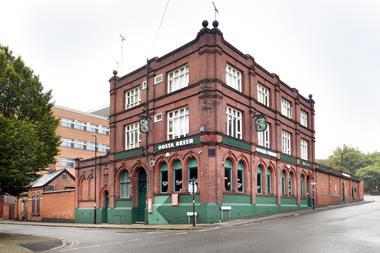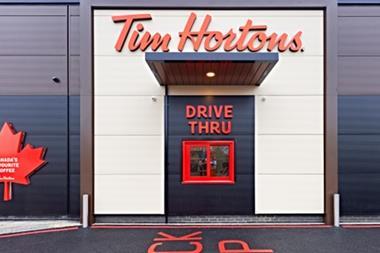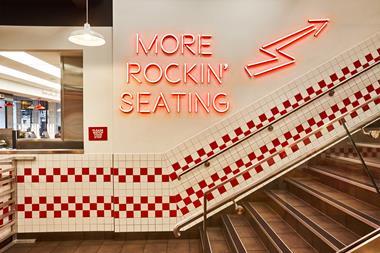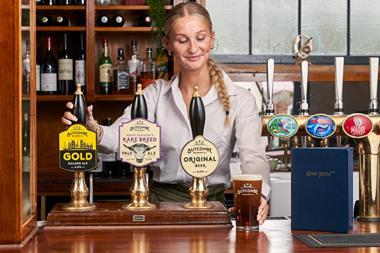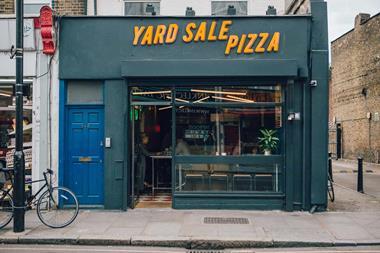Crowdfunding has become a popular way for cash-strapped chefs to launch their own restaurants. But is it the source of easy money many people think it is?
Media attention was frenzied last November when Nuno Mendes launched an audacious £1.75m crowdfunding bid to reopen his restaurant Viajante in Wapping’s Metropolitan Wharf. The move followed a number of successful bids to open restaurants, including a recent one from Thai restaurant Som Saa, which exceeded its pitch target of raising £550,000 in just four days (it ended up hitting £700,000) and upped the ante in the crowdfunding game.
While Mendes was seeking to raise significantly more money than many other crowdfunding pitches, his high-profile chef status meant that many believed he would hit his target. The inclusive nature of the bid, with the minimum investment starting at just £10 ‘so that all foodies can take part’, also gave it a strong chance of success.
Yet it wasn’t to be. At Mendes’ request the campaign, run through crowdfunding platform Seedrs, was ended early after it became evident that the requisite money wouldn’t be found. It was the first high-profile restaurant crowdfunding bid to fail and a potent sign that the platform isn’t the source of easy money many think it is.
Mendes’ experience isn’t a one-off. Café Provencal, a neighbourhood restaurant in Herne Hill, south London, tried to raise a more modest £30,000 in September last year. Two summers previously, the area was flooded by a burst water main, and although owner Adam Shipley had reopened, things were looking bleak, with less money from the insurance than expected and other related expenses. So one afternoon he sat down and created a Crowdfunder campaign.
Despite getting 172 backers for the project, Shipley only managed to raise less than a third (£9,085) of the target in 56 days, with 100 people pledging just £10 or £20 and 35 people bidding the maximum amount, which was a modest £100.
Another casualty in the fundraising game is James Watson’s upmarket Hidden Kitchen in
St Ives, Cornwall. Watson attempted to raise £10,000 to complete the renovation of the restaurant’s dining room and upgrade the kitchen, but ended well short, raising £2,990 through 42 backers. Unable to get the support, he had to turn to the bank of mum and dad (and the in-laws too) to get his venture off the ground. “The biggest problem was our older clientele. The over-50s didn’t get the rewards concept,” he says. “They thought, ‘why am I paying in advance to order dinner?’ Plus we were the first in St Ives to do it, which didn’t help.”
Despite such failures, crowdfunding looks set to continue to be a chosen avenue for restaurants over the next few years. And for obvious reasons. Success stories include BrewDog, which has raised an incredible £13.5m since it launched its Equity for Punks crowdfunding campaign; River Cottage, which crowdfunded £1m; Pizza Rossa (£440,000); and Chilango (£2.2m in 2014 and £3.4m in 2015); showing that investors are willing to put their hands in their pockets if the offer is right.
Since Kickstarter launched in 2009, others have followed suit, be they equity models, where investors get a share of the business, or rewards-based schemes, meaning there are now plenty of platforms available for people to raise funds through. Crowdcube has funded 324 UK projects, or ‘pitches’, 100 in the food and drink industry, of which 14 are restaurants, none of which are thought to have since closed. For many operators, crowdfunding remains the only avenue available.
When Gary Usher opened his second restaurant, Burnt Truffle, in Heswall, Merseyside, crowdfunding was the only option open to him. The chef had initially approached the banks for finance but after receiving a number of knock-backs he took to the crowdfunding platform Kickstarter. Usher kept his target realistic, seeking £100,000 from the site to part fund the restaurant – which eventually came in at £250,000 – a target he achieved. “We knew we were going to need more than £100,000 but, because Sticky Walnut [Usher’s first restaurant] does so well, we felt confident we’d be able to wing it,” he says.
Buoyed by the process, Usher is turning to crowdfunding again to finance his third restaurant, Hispi, due to open in Chorlton, south Manchester, this summer. This time round, he is looking to raise £50,000 for the new venture.
Crowdfunding might still be a viable source of income, therefore, but there are things that prospective businesses can learn from the past few years that will increase their chances of success. With the rate of funding success across the board at 52%, around half of restaurant campaigns won’t make the grade. In order to increase their success rate, restaurants need to put in the groundwork and make sure they are utilising all the social media avenues available to reach out to their loyal fan base and hustle up interest, says Crowdcube co-founder Luke Lang.
“For restaurants that choose to raise finance through crowdfunding, the main pitfall to avoid is failure to engage their own crowd,” he says. “Restaurants with an existing network of customers and suppliers are at an advantage, so an important part of a restaurant’s crowdfunding strategy should be engaging its existing community and offering them the opportunity to invest. Reaching the first 10% of an investment target is the hardest part, so businesses that are able to leverage existing networks to raise investment and get early momentum are more likely to succeed.”
Shipley is candid about why he only raised a third of his Crowdfunder target. “I’m useless at social media,” he admits. “Unless you know what you’re doing, you need to get someone social-media savvy to blitz your customers beforehand and join up the campaign across Facebook and Twitter. It wasn’t until I did this, 10 days from the end of the campaign, that things really took off.”
Even experienced crowdfunders can underestimate the power of awareness when looking to raise funds. London Union co-founders Henry Dimbleby and Jonathan Downey used crowdfunding to try to raise
£1m with a stretch target of £3.5m to find a permanent central London home for Street Feast – their popular street food market. The pair has form with raising funds through less-than-conventional methods. Downey’s Rushmore Group became the first business to raise more than £1m using a crowdfunding platform, while Leon, the healthy fast-food chain that Dimbleby co-founded, attempted to raise £1.5m through a customer bonds scheme.
The bid closed short of their most optimistic aims, with London Union raising £2.5m in 30 days. According to Dimbleby, if he crowdfunded again, he would spend more time creating a buzz beforehand. “We were too busy, but not doing that made it harder to get funding,” he says.
Setting the right rewards and equity levels is also important. Robin Frean, who smashed his modest £5,000 target when he raised £10,535 for his restaurant Hood in Streatham, south London, through Crowdfunder, credits his success to setting realistic rewards. He advises other restaurateurs to look at costs carefully so, for instance, a three-course meal for £50 pledged doesn’t cost so much that you’re out of pocket, and to be realistic about what they are able to deliver. Frean harnessed social media to put out teasers about the restaurant and entice local families, all tapping into the enthusiasm for the area’s regeneration.
Usher took a similar approach with Burnt Truffle, with most of the money raised through selling meals in advance. The delay in its opening meant many of these meals were honoured at Sticky Walnut.
Downey and Dimbleby took a slightly different tack, choosing to make their minimum investment higher than average. This might seem counter intuitive, but having a starting investment of £5,000 was designed to limit the number of shareholders the company had to deal with. “We’d heard that if you have a much larger group of shareholders then a lot of them can be looking for special treatment, which could create problems,” says Dimbleby.
Having a low investment strategy also puts pressure on a restaurant to seek a large number of backers. Usher had just short of 900 for Burnt Truffle and chef Paul Foster, who has just launched a Kickstarter bid to open his own restaurant, is likely to need a similar number. At the time of writing, his bid for £100,000 had hit a quarter of its target with 240 backers.
This higher level of investment might have been a reason why London Union didn’t hit its £3.5m target in the allotted time, but Downey and Dimbleby aren’t concerned. The exposure London Union’s bid got means it will be able to raise the final £1m through private investors. “Crowdfunding puts you in play,” says Downey. “A lot of people know about London Union and there has been a lot of private interest on the back of this. We will be able to build a war chest.”
Indeed, Mendes also says that although his Seedrs bid was aborted, the awareness it received has opened up further opportunities. “The crowdfunding campaign was an exciting platform to measure people’s appetites for Viajante,” he says. “It has provided such international awareness that we are now exploring other exciting avenues of investment.”
Securing funding is only part of the battle, however. Kickstarter has seen its first closure: Pure Taste, ‘the UK’s first gluten-free, paleo restaurant’, which opened in Notting Hill in November 2014 and lasted only seven months.
Pure Taste had raised £32,165 with a £30,000 goal. The campaign particulars suggest that owner Holly Redman had done her financial projections and had also previously trialled the concept as a sell-out pop-up for 10 months, which showed relative newbies can do it too.
So why did she end up £91,000 in debt and feeling like she’d let everyone down (as per her Kickstarter page statement)?
Partly she attributes this to taking a site that she knew was too big because “the anticipation had become too much and it felt like we just needed to get open somewhere”. She helpfully lists some lessons for those thinking of taking a similar path. These include financial hints such as “make sure you have enough working capital”, “don’t start out with too much debt”, “keep staff hours on a tight leash”. Other tips include: “try not to let enthusiasm or stress blind you to advice and reality”, “really research your location” and “try to make sure your concept has mass-market appeal”.
Thomas Davies, chief investment officer of equity crowdfunding platform Seedrs, says a restaurant opened through equity crowdfunding is no more likely to close than one opened with bank backing. Seedrs’ campaigns take an average 27 days to hit target with funding from an average of 165 investors. Davies’ advice is “don’t be afraid to shout about what you’re doing. Convert your customers, your extended family and friends in the first instance and the serious investors will follow.”
He says Seedrs ensures the structure is watertight: “We want to see the complete team package – so you have the passionate founder/chef but you also need the financial and marketing cornerstones. Our crowds of investors are very, very smart people.”
He concedes that reward schemes like Kickstarter might draw in people who like
the idea creatively without looking at the financial side.
Of course Kickstarter disagrees. A spokesperson describes equity crowdfunding as “incredibly limiting. When ideas are judged on their merit rather than the promise of profit, they can escape conventional measures of success and you’ll see big, bold ideas come to life. People back projects on Kickstarter out of love; not because they want to make a buck off someone else’s idea.”
As a way of driving awareness of a potential new venture, crowdfunding is still very effective. Yet, the days of simply choosing a platform and waiting for engaged food lovers or minted investors to make the dream a reality are long gone. And, as more restaurants turn to crowdfunding, and more inevitably fail to hit their target, and some even close after launch, potential investors are likely to become more selective about who they back.
Mark Tenzer, partner at accountancy firm Jeffreys Henry LLP, says restaurants need to get their projections right first time if they want long-term success. “Avoid just raising enough to get started. You need to leave some working capital for seasonal variations, at least for another six months, ideally 12.”
Tenzer also sees a future where companies that have already crowdfunded and are looking to do it again for expansion, could find themselves in a tricky situation. “Try to think ahead and not give away too much equity the first time around,” is his advice.
Despite its detractors and pitfalls to be negotiated, Dimbleby thinks crowdfunding will run and run. “It’s in its infancy,” he says. “It’s a disruptive influence and we’re going to find banks buying out crowdfunding companies as they realise they’re losing a big section of the market.”


























